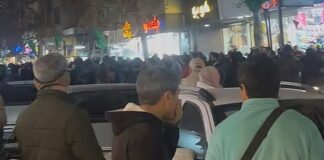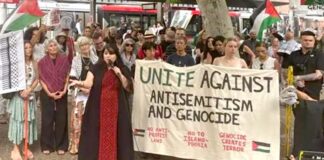Mark Goudkamp takes a look at the SBS series Immigration Nation and its history of the White Australia policy
SBS’s Immigration Nation is an informative and timely three-part documentary that examines the founding of White Australia, and how Australia has become a multicultural nation despite its deeply racist origins.1
It dissects a paradox fundamental to the creation of the Australian nation. While our “founding fathers” trumpeted their “idealism” in setting up a “working man’s paradise”, this “utopia” explicitly excluded the overwhelming majority of the world’s population on the basis of race.
Racist beginnings
The first episode starts with Federation in 1901, and the very first act of the federal parliament, the Immigration Restriction Act. Commonly known as the White Australia Policy (WAP), it discriminated against both new entrants and non-Europeans already living in Australia.
The ALP opposition wanted to ban all non-whites from even entering the country. Britain opposed the measure saying it would offend the British Empire’s non-white subjects, yet Labor’s more racist amendment was only defeated by five votes.
The WAP resulted in immediate moves to deport Melanesians who’d been “blackbirded” as cheap labour for Queensland’s sugar plantations (although many who’d arrived before the 1885 act which changed their status could stay legally, while others went into hiding).
Australia’s significant Asian communities were also hit hard.
While many Asian-Australians were enthusiastic about the official Federation celebrations, the Chinese community was soon “strangled” by the WAP. By the 1920s, Australia’s pre-Federation Chinese population of 50,000 had halved, plummeting to just over 9000 by 1940. It wasn’t until the late 1980s that pre-Federation numbers were reached.2
Whose interests did the WAP serve?
Unfortunately, Immigration Nation tends to recite the commonly held idea that the introduction of White Australia was in the interests of, and driven by, the organised Australian working class.
On the contrary, as Phil Griffiths argues in his recent PhD thesis, the WAP developed, “as a ruling class attempt to secure three major objectives: Anglo-Australian colonisation of the continent; a modern rather than indentured labour economy, across the whole continent; and a ‘homogenous’ population”. Key figures in the colonial bourgeoisie fought for this agenda from 1876, and the first WAP, agreed at the Intercolonial Conference of 1888, prevented Chinese immigration and severely constrained the employment of non-waged Pacific Islanders in Queensland. Griffiths adds that, “The laws adopted in 1901…represented a broadening and consolidation of the principles established in 1888.”3
Griffiths also points out that every anti-Chinese law passed prior to 1890 was passed by parliaments dominated by squatters, rich lawyers, merchants, wealthy manufacturers, and newspaper owners. Those parliaments never had more than two people who’d been tradespeople or working class when elected.
The documentary itself acknowledges that it was a book by Charles Pearson, National Life and Character: a Forecast, published in 1893, which provided the intellectual basis for White Australia.
Pearson, who had been Education Minister in Victoria and headmaster at Pymble Ladies College, and who was described as an “outstanding intellectual of the Australian colonies”, promoted the idea that the white man was under siege, arguing that the “Black and Yellow” races were ascendant, powered by population increase and industrial capacity.
Speaking in parliament in favour of White Australia in August 1902, conservative Prime Minister Edmund Barton favourably quoted Pearson:
“The day will come, and perhaps is not far distant, when the European observer will look round to see the globe girdled with a continuous zone of the black and yellow races… The citizens of these countries will then be taken up into the social relations of the white races…and will be admitted to inter-marriage. It is idle to say that if all this should come to pass our pride of place will not be humiliated…”4
Karl Marx famously wrote that “the ruling ideas of any age are the ideas of its ruling class”. Clearly, Pearson and Barton were expressing the ideas of the fledgling Australian bourgeoisie.
The documentary should have interviewed academic Verity Bergmann who, in a groundbreaking collection of essays on working class racism, explained how the lack of class consciousness caused by the “method of settlement and economic development in Australia in the 19th century led trade unions to support campaigns of hostility to selected immigrant scapegoats”5.
“Australian working class racism was fed by the perceived tendency of coloured immigrants to work for lower wages but this was the fault of the racist attitudes of the trade unions which excluded coloured immigrants and organised against rather than with them”. Conversely, “Employers benefited directly from white worker antagonism to Chinese workers, as a cheap labour supply could only remain cheap if organisationally distinct from the rest of the labour force.”6
In addition, Immigration Nation equates the labour movement with the racist Labor and AWU leadership. It fails to acknowledge the role of radical left groups like the IWW (in the early twentieth century), and the Communist Party (in the 1920s and 1930s) in resisting the prevailing racist ideology. By comparison, opposition to White Australia from the Australian ruling class did not emerge until the early 1960s.
Racism and imperialism
Immigration Nation describes how Australian ruling class concerns with regional rivals fed the anti-Asian racism. In international talks at the end of WWI, Japan tried to insert a Racial Equality Clause into the League of Nations charter.
But Labor Prime Minister Billy Hughes threatened that Australia would leave the talks if this clause was passed, absurdly arguing that it would insult the death of the 60,000 diggers who had died for the British Empire. Only the other white colonial settler states like South Africa and New Zealand explicitly supported Australia’s overt racism. But Britain, the US and France quietly encouraged Hughes and ensured Japan’s clause was defeated as they too feared that Japan’s rapid rise threatened their global dominance.
‘Populate or perish’
By the end of WWII, Australia’s seven million people were overwhelmingly white. But Labor’s post-war Prime Minister Ben Chifley wanted to triple the population. Australia’s first Immigration Minister, Arthur Calwell, used the fear of Japan and Asia generally to overcome hostility to mass migration and to win support for his slogan of “populate or perish”. Ironically, this paranoia about Asia led to a dramatic change in the composition of Australia’s population.
With Britain unable to provide enough migrants, Calwell announced a preference of “10 Poms for each ‘foreigner’”. Immigration officers such as George Kiddle were sent to refugee camps in Germany. He was told to “handpick Beautiful Balts”. Using “medical” checks (they had to be 75 per cent white) that Kiddle said were “reminiscent of Hitler’s Germany”, those who best fitted Australia’s racist policy were selected. While they weren’t British, they were “the next best thing”.
Even so, in April 1947 when the Neeza arrived in Melbourne with 600 people from 26 countries, a media frenzy erupted over dark skinned arrivals threatening the WAP.
In 1949, as the post-war economy’s demand for labour increased, Calwell increased the migration quota from 110,000 to 150,000. At the very same time however, around 6000 Asian refugees, mostly mainland Chinese who’d fled Japanese occupation, were deported.
Liberal hero Robert Menzies crushed Labor in the 1949 federal elections. His dream of a “British Australia” meant that although migration from “not-so-white” Southern European nations increased during the 1950s, a policy of assimilation was vigorously applied to both non-white migrants and to Aboriginal people.
The beginning of the end of the WAP
As anti-imperialist movements grew after WWII, and the Chinese Revolution inspired “communist” uprisings in Asia, Menzies added the colour “red” to the Australian elite’s long-held paranoia about the “yellow peril”.
Menzies tried to combat Communism with the Colombo Plan which brought Asian university students to Australia with the hope that they would return home with a glowing view of Australian society. Instead, they mingled with a new generation of Australian-born students who were starting to question the White Australia Policy. John Menadue, who in the late 1970s became the head of the Department of Immigration, relates how his initial shock at sharing his University of Adelaide room with three Malaysians evaporated once he tasted his first curry.
Menadue joined the campus ALP club along with Don Dunstan, and they, together with the likes of Victorian Gough Whitlam, began to challenge Labor policy from within. In 1965 the WAP was finally dropped from the ALP’s platform.
From 1961, Melbourne University group Student Action was holding protests against the WAP, with placards like: “Mind that tan, they might deport you!” Then in 1964, the case of five-year-old Nancy Prasad blew the WAP apart. Nancy’s Fijian parents had been deported, but her two older siblings—both married to Australians—were allowed to stay. When Nancy was threatened with deportation, her sister mounted a public campaign demanding the right to adopt her.
Liberal Immigration Minister Hubert Opperman was outraged at the family’s audacity. But with the family on the run, they attracted widespread support. On national TV, Aboriginal activist Charlie Perkins drew comparisons between anti-Aboriginal racism and that suffered by non-white migrants. While the campaign could not prevent Nancy’s deportation, opposition to WAP was boosted.
The White Australia policy had always dogged relations between Australia and its Asian neighbours. Ruling class opinion began to shift as the WAP became an obstacle to Australia playing a bigger economic and political role in Asia. Soon after Harold Holt was sworn in as Prime Minister on Australia Day 1966, he announced an annual intake of 6500 highly skilled Asian migrants.
White Australia wasn’t quite yet dead. Despite the success of the 10 pound Pom migration scheme, in 1971 a highly qualified British man was denied entry—he might have been British, but he was black!
In November 1972, Gough Whitlam led the ALP to victory and appointed Irish-Spanish Al Grassby as Immigration Minister. Grassby toured Asia to announce that the “WAP was over”, and announced he’d be happy to take back Nancy Prasad.
The documentary asks, “but was it really buried? It’s suggested that, like Kevin Rudd 35 years later, Whitlam was big on symbolic acts, without driving fundamental change. The arrival of Vietnamese boat people put Whitlam’s government to the test.
The mass movement against the Vietnam War and TV images of Vietnamese people suffering had further shifted attitudes towards Asian people. Yet Whitlam announced that Australia would take just 1000 Vietnamese refugees, fearing that supposed “anti-communist” Vietnamese refugees would never vote Labor.
While Whitlam passed the Racial Discrimination Act in 1975, praise is heaped on his Liberal successor Malcolm Fraser for welcoming refugees from South East Asia.
But that is not the whole story. The Fraser government demanded boat arrivals be kept low key—for example, there was little mention of a boat that sailed right into Darwin harbour on Anzac Day 1976 (the crew had only a school atlas to guide them!). Immigration Nation notes Fraser’s role in setting up refugee camps in Malaysia and Indonesia, but omits the more telling side of Fraser’s policy. An immigration officer of the time, Greg Humphries, has revealed:
“We located many a boat coming down the Malaysian peninsula. We encouraged the Malaysians to land them, put them in the camps so that they could be processed. There were still a percentage of the boats, eh, people themselves, who were determined to push on to Australia. Well, we took a pretty broad interpretation of the terms of reference to stop these boats we did…we had some very capable fellows with their screwdrivers and brace and bit. We bored holes in the bottom of the ships…and they sank overnight…we were very successful in stopping many of the boats, by one way or another.”7
Nonetheless, Fraser’s acceptance of 70,000 Vietnamese refugees is a sharp contrast with the stance of both Labor and Liberal governments since Labor’s Paul Keating introduced mandatory detention in 1992.
At the end of the final episode, John Howard’s infamous 2001 election speech (“We will decide who comes to this country, and the circumstances in which they come”), is neatly juxtaposed with what Julia Gillard said upon outsing Kevin Rudd (“Australians are concerned when they see boats on our horizon and they wanna (sic) make sure that the government is actively managing to protect our borders.”
Given what has happened with multiculturalism and asylum seekers over the past 30 years, Immigration Nation really needs a fourth episode. It will be up to us to ensure it has a better ending.
Notes
1 The series webpage also has an “interactive documentary”, with more detail on “building multicultural Australia”, including a link to footage of the Ford Broadmeadows strike of 1973, and the migrant women’s campaign against BHP for equal employment rights. There is a useful study guide for teachers.
2 Figures from Melbourne’s Chinese Museum: www.chinesemuseum.com.au/history.html
3 Griffiths, P. The Making of White Australia: Ruling Class agendas 1876-1888, PhD thesis, 2006, Australian National University. Available at http://thesis.anu.edu.au/uploads/approved/adt-ANU20080101.181655/public/02whole.pdf
4 Wikipedia entry on Charles Henry Pearson: http://en.wikipedia.org/wiki/Charles_Henry_Pearson
5 Bergmann V. “Capital and Labour”, in Markus A. and Curthoys A. (eds) Who are our enemies? Racism and the working class in Australia, Hale & Ironmonger, 1978, pp25, 34.
6 Bergmann V., p22.
7 Admission Impossible, Alec Morgan’s brilliant 1992 documentary.





